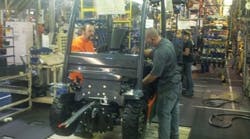The “Top Guns” at Toyota Industrial Equipment Manufacturing (TIEM) swarm the plant looking for ways to reduce environmental impact through waste paper reduction. Aptly named Top Guns, this TIG (Toyota Improvement Group) team embodies the spirit of continuous improvement that permeates this plant which produces 59 models of Class 1, 4, or 5 lift trucks and Class 6 towing tractors.
With a 62% participation rate by hourly associates, the TIG Groups hone in on improvement projects through a structured program that includes choosing themes, creating countermeasures and measuring results. Participation is voluntary, but there are some incentives such as paid overtime to work on the projects as well as pay based on completion of projects. The scope of a project is determined by the group based on an eight-step problem-solving technique. Competition, both against internal teams and corporate-wide, is a key element to the program.
“One important aspect of this project is that it empowers people to solve their own issues,” explains Scott Redelman, manager, production control. “Management isn’t here to solve all of the problems, but instead to provide direction and support. Everyone takes a lot of pride in finding solutions.”
Along with TIG, there is also Jishunken activity, which involves four groups that consist of associates and leaders from across the company, that work on specific projects for four to five months, in such areas as safety, quality and productivity.
“For any improvements we do, we always start with the basics of 5S and standardization, “says Tony Miller, plant manager and vice president, manufacturing and engineering. The company also enlists employee suggestions, which last year amounted to 28 per employee and saved the company $717,000.
While employees keep a close eye on improving processes, the company stays focused on assisting employees through a variety of programs, including an on-site medical clinic as well as monthly social projects and recognition programs.
“Our focus is on fostering a sense of belonging to the company, rather than working for the company,” says Bruce Nolting, vice president, production control purchasing. “We have many levels of communication, one of the most important being the interaction between associates. Supervisors’ offices are located on the floor and they spend most of their time walking the floor answering questions and listening to concerns.”
One technique the company uses to both develop loyalty and transfer knowledge across the organization is to have associates rotate jobs and departments. Every six months all levels, up to vice presidents, change responsibilities and assignments.
During recent difficult times when sales dropped off considerably, the TIEM facility demonstrated its loyalty to associates by keeping full-time employees on staff. One strategy to keep employees working was to bring more parts production in-house. For example in 2008 the company installed a laser cutting machine for steel which allowed TIEM to cut, stamp and manufacture more than 700 parts. “This has also lowered our costs and assured better quality,” says Miller.



